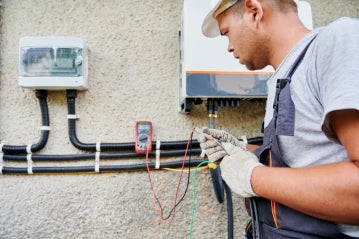
As the demand for renewable energy continues to rise, more homeowners are turning to solar power to meet their energy needs. Solar energy is clean, sustainable, and cost-effective, making it an appealing choice for environmentally conscious individuals. However, before investing in solar energy systems, it's important to address common concerns, such as the potential noise produced by solar inverters. In this article, we will explore the topic of solar inverter noise, factors influencing it, and strategies to mitigate any unwanted sounds.
1. Understanding Solar Inverter Noise
Solar inverters are an integral part of any solar energy system, responsible for converting direct current (DC) electricity generated by solar panels into alternating current (AC) electricity for household use. While solar inverters are generally designed to operate silently, some models may produce a certain level of noise due to various factors.
2. Factors Influencing Solar Inverter Noise
a) Inverter Type: Different types of solar inverters, such as string inverters, central inverters, and microinverters, may vary in their noise levels. It's important to research and choose an inverter known for its low noise operation.
b) Manufacturer and Model: The quality and design of the inverter can affect its noise levels. Reputable manufacturers with a track record of producing reliable and quiet inverters should be favored.
c) Ambient Temperature: High temperatures can cause the inverter's cooling system, such as fans, to work harder, potentially leading to increased noise levels. Optimal installation in a well-ventilated area can help alleviate this issue.
d) Installation Location: The location of the inverter plays a significant role in noise production. Placing the inverter away from living areas or using sound-absorbing materials during installation can minimize noise disturbances.
e) Cooling Fan: The cooling fan inside the inverter can generate noise, especially when it operates at higher speeds. Choosing inverters with efficient and quieter fan designs can help reduce noise.
f) Inductor Coil: Inverters may contain inductor coils that can produce audible vibrations and noise. Opting for inverters with better insulation and vibration dampening features can mitigate this issue.
3. Noise Reduction Strategies for Solar Inverters
a) Choose a High-Quality Inverter: Prioritize inverters from reputable manufacturers known for producing silent or low-noise models. Reading customer reviews and seeking professional recommendations can be helpful in making an informed decision.
b) Opt for Microinverters: Microinverters, which are installed individually behind each solar panel, can reduce overall system noise as they distribute the load and noise across multiple units. Additionally, microinverters offer other advantages such as increased system efficiency and monitoring capabilities.
c) Proper Installation: Ensure that the inverter is installed by qualified professionals who follow manufacturer guidelines. Proper installation can minimize potential vibrations and noise.
d) Acoustic Barriers and Enclosures: Installing sound-absorbing materials or enclosures around the inverter can effectively reduce noise transmission. Consult with experts to determine the most suitable materials and techniques for noise reduction in your specific setup.
e) Regular Maintenance: Perform routine maintenance on your solar energy system, including the inverter. Keep the inverter clean, check for any loose components or obstructions, and ensure proper functioning of the cooling fan, as inadequate maintenance can lead to increased noise levels.
f) Install a Noise Barrier: If the inverter noise persists, consider installing a noise barrier between the inverter and living areas. This can be achieved through the use of sound-absorbing panels, fences, or even strategically placed vegetation.
4. Identifying Different Types of Noise from Solar Inverters, Causes, and Solutions
a) Humming Noise: A low humming noise may indicate the normal operation of the inverter. However, if the noise becomes excessive or unusual, it is recommended to consult a professional to identify and address any underlying issues.
b) Whistling Noise: Whistling sounds may be caused by airflow disruptions or loose components within the inverter. Proper maintenance, such as cleaning or tightening loose parts, can resolve this issue.
c) Clicking Noise: Clicking noises can occur due to relay switching or power fluctuations. If the clicking noise is irregular or accompanied by abnormal inverter behavior, contacting a professional for further inspection is advisable.
d) Buzzing Noise: Buzzing noises can be a result of loose wiring or faulty electrical components. Promptly addressing such issues through professional assistance is crucial to ensure the safety and optimal functioning of the system.
e) Grinding Noise: Grinding noises may indicate mechanical faults, such as a malfunctioning cooling fan or damaged bearings. It is important to contact a qualified technician to diagnose and resolve these issues promptly.
Conclusion
While solar inverters generally operate silently, certain factors can contribute to noise production. By understanding the factors influencing inverter noise and implementing appropriate strategies, homeowners can ensure a quiet and efficient solar energy system. When choosing solar inverters, prioritizing reputable manufacturers, opting for microinverters, and considering noise reduction techniques during installation are essential. Regular maintenance and addressing any unusual or excessive noises promptly will help maintain the overall performance and longevity of the solar energy system, providing a seamless and noise-free experience for customers investing in solar power.
Silence the noise from solar inverters and unlock a peaceful solar energy solution for your home. Experience the quiet revolution of clean power today!



0 comments